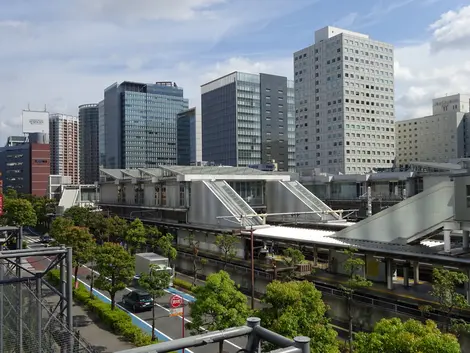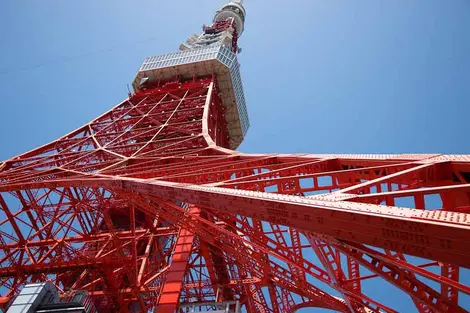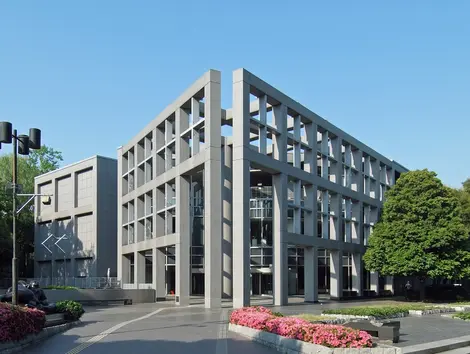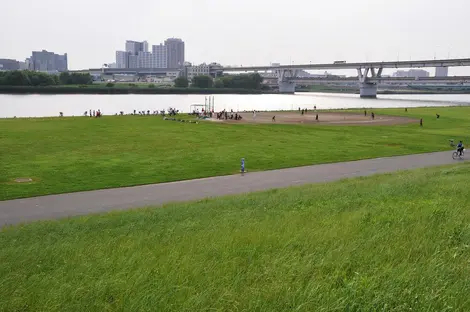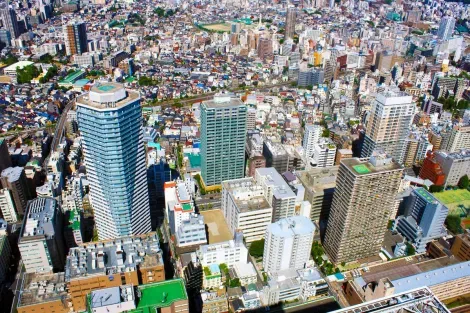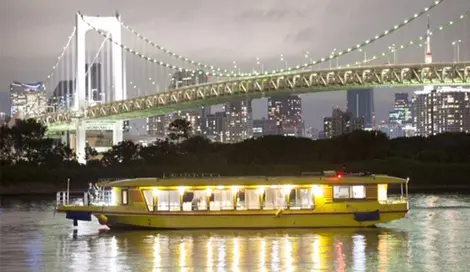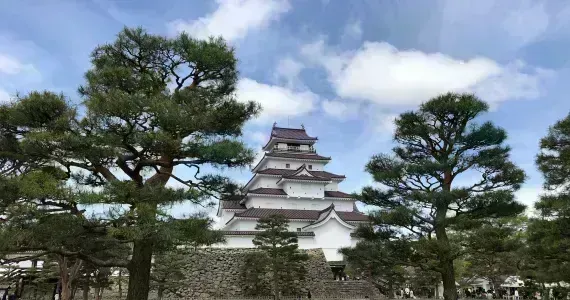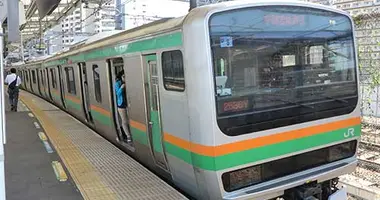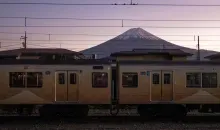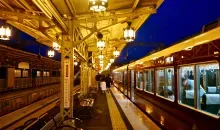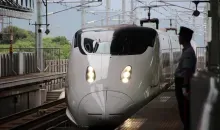Saikyo Line 埼京線
The Saikyo Line is a Japan Rail line connecting Saitama prefecture in the north with Tokyo. The Kawagoe and Rinkai lines connect to the Saikyo LIne at its the north and south ends.
JR Saikyo Line
The Saikyo Line is a Japan Rail train line running north-south through greater Tokyo, from Omiya Station in Omiya (in Saitama prefecture) through Tokyo, down to Osaki Station in Shinagawa.
At both ends of the Saikyo lines are other connected lines by which certain trains continue further west and east:
-west from Omiya as far as Kawagoe Station on the Kawagoe Line, and
-east from Osaki as far as Shin-Kiba Station, by Tokyo Bay, on the Rinkai Line.
The "sai" in Saikyo is from Saitama" and the "kyo" from "Tokyo," reflecting the line's role in connecting the two areas.
Teal is the color of Saikyo Line trains and of the Saikyo line on maps.
Saikyo Line Stations
There are 19 stations on the Saikyo Line proper, with an additional five stations extending from the northern Kawagoe end on the Kawagoe Line, heading west, and seven stations continuing on from the southern Osaki end on the Rinkai Line, heading east.
Three types of train run on the Saikyo Line: Local (kaku-eki-teisha), stopping at every station; Rapid (kaisoku); and the rush-hour-only Commuter Rapid (tsukin kaisoku).
On the northern half of the line, from the northernmost station of Omiya down to Akabane, the Rapid stops at only three of the 12 stations: Toda-Koen, Musashi-Urawa and Yonohommachi, while the Commuter Rapid stops at only one station: Musashi-Urawa. All trains stop at all stations on the rest of the line, and all Saikyo Line trains that continue on to the Kawagoe and Rinkai lines stop at all stations on those lines.
The Saikyo Line runs parallel to the Yamanote Line for five stations, from Osaki to Ikebukuro.
Kawagoe Station 川越駅
Kawagoe is a historic castle town near Tokyo with an atmosphere reminiscent of old urban Japan.
Transfer at Kawagoe Station (on the Kawagoe Line) to the Tobu Tojo Line.
Honkawagoe Station, the terminal station of the Seibu-Shinjuku Line, is 6-7 minutes walk left out of the East Exit of Kawagoe Station. Long distance buses depart from the bus station in front of the East Exit, to Narita Airport, Haneda Airport, Tokyo Disney Resort, Osaka and Kyoto.
Minami-Furuya Station 南古谷駅
Minami-Furuya Station is in the Namiki district of Kawagoe City. There is a sizable shopping district about 5 minutes walk north-west of the station. There are no transfers at Minami-Furuya Station.
Sashiogi Station 指扇駅
Sashiogi Station is in Nishi Ward, Saitama City. The Omiya International Country Club is about 1 km north-west of the station. There are no transfers at Sashiogi Station.
Nishi-Omiya Station 西大宮駅
The Nishi Ward Office (Nishi Kuyakusho 西区役所) is about a five minute walk north of Nishi-Omiya Station.
There are no transfers at Nishi-Omiya Station.
Nisshin Station 日進駅
Omiya Station 大宮駅
Omiya is Saitama prefecture's shopping, entertainment and sightseeing hub. The Railway Museum is a must-see for trainspotters and a highly recommended attraction for those with even a passing interest. Omiya Park (Omiya Koen) one kilometer north-east of Omiya Station is renowned for its cherry blossom every spring. Hikawa Shrine is a magnificent Shinto shrine with a long history, located alongside Omiya Park. Saitama Prefectural Museum of History and Folklore (9 am - 4:30 pm , but open until 5 pm ; closed Mondays, except when Monday is a national holiday, or falls on May 1 or 2; 300 yen for adults) is also in Omiya Park. Omiya Bonsai Village with its Omiya Bonsai Art Museum is two stops north of Omiya Station, and can be accessed from either Omiya Koen Station on the Tobu Noda Line or Toro Station on the JR Utsunomiya Line.
Transfer at Omiya Station to the Keihin-Tohoku Line, JR Utsunomiya Line, Tobu Noda Line, Shonan-Shinjuku Line, Ueno Tokyo Line, Narita Express, Takasaki Line, Kawasaki Line, Tohoku Shinkansen, Joetsu Shinkansen, Hokuriku Shinkansen, Akita Shinkansen, Yamagata Shinkansen, and the New Shuttle.
Kita-Yono Station 北与野駅
Saitama Super Arena is about 5 minutes walk north-east from Kita-Yono Station, and is a popular stadium that hosts big names in sport and music. Cocoon City shopping center is also quite near Kita-Yono Station.
There are no transfers at Kita-Yono Station, however Saitama-Shintoshin Station on the Keihin-Tohoku Line is about 6-7 minutes walk north-east.
Kita-Yono Station has blue platform struts to help passengers identify it.
Yono-Hommachi Station 与野本町駅
The Saitama branch of the Tokyo Immigration Bureau is about 6-7 minutes walk north-east from the East Exit of Yono-Hommachi Station.
There are no transfers at Yono-Hommachi Station.
Yono-Hommachi Station has flesh (more like "peach") platform struts to help passengers identify it.
Minami-Yono Station 南与野駅
Saitama Museum of Modern Art (MOMAS) (10 am - 5:30 pm, last entry 5 pm, closed Mondays (except on national holidays, Saitama Residents' Day, New Year, and for maintenance) is about 15 minutes walk east from the East Exit of Minami-Yono Station, located in Kita-Urawa Park which has a music fountain that plays for 10 minutes every two hours between 10 am and 8 pm (until 6 pm Sep-Feb). Just beyond the Museum is Kita-Urawa Station on the Keihin-Tohoku Line
There are no transfers at Minami-Yono Station.
Minami-Yono Station has green platform struts to help passengers identify it.
Naka-Urawa Station 中浦和駅
Besshonuma Park with its woods and big lake is 4-5 minutes walk north-east from the East Exit of Naka-Urawa Station.
There are no transfers at Naka-Urawa Station.
Naka-Urawa Station has canary yellow platform struts to help passengers identify it.
Musashi-Urawa Station 武蔵浦和駅
There are no transfers at Musashi-Urawa Station; however Musashi-Urawa Station on the Musashino Line is about a 1 minute walk east.
Musashi-Urawa Station has pink platform struts to help passengers identify it.
Kita-Toda Station 北戸田駅
There are no transfers at Kita-Toda Station.
Kita-Toda Station has orange platform struts to help passengers identify it.
Toda Station 戸田駅
Toda City Hall (Toda Shiyakusho 戸田市役所) is about 10 minutes walk east of Toda Station.
There are no transfers at Toda Station.
Toda Station has red platform struts to help passengers identify it.
Todakoen Station 戸田公園駅
The Arakawa River, its banks forming parks and recreation areas, is 10-15 minutes walk south of Todakoen Station.
There are no transfers at Todakoen Station.
Todakoen Station has pale blue platform struts to help passengers identify it.
Ukimafunado Station 浮間舟渡駅
Ukima Park with its life-sized windmill and lake with birdlife, surrounded by trees (including cherry blossom in spring) is a one minute walk east of Ukimafunado Station. The west bank of the Arakawa River is just beyond Ukima Park.
There are no transfers at Ukimafunado Station.
Ukimafunado Station has light green platform struts to help passengers identify it.
Kita-Akabane Station 北赤羽駅
The west bank of the Arakawa River is about 6 minutes walk north-east of Kita-Akabane Station.
There are no transfers at Kita-Akabane Station.
Kita-Akabane Station has lilac platform struts to help passengers identify it.
Akabane Station 赤羽駅
The Akabane Station houses many stores, and there is more shopping and commerce to the east of the station.
Transfer at Akabane Station to the Keihin-Tohoku Line, Tohoku Main Line (Utsunomiya Line), Takasaki Line and the Shonan-Shinjuku Line (the Takasaki Line is covered by certain Shonan-Shinjuku Line trains).
Jujo Station 十条駅
Pretty Nanushi-no-Taki Park with streams and a waterfall is about 10 minutes walk east-southeast of Jujo Station.
There are no transfers at Jujo Station; however Higashi-Jujo Station on the Keihin-Tohoku Line is about 7-8 minutes walk north-east, and Oji-Kamiya Station on the Tokyo Metro Namboku Line is about 15 minutes walk east.
Itabashi Station 板橋駅
There are no transfers at Itabashi Station; however Shin-Itabashi Station on the Toei Mita Subway Line is about 5 minutes walk north.
Ikebukuro Station 池袋駅
Ikebukuro is a large shopping and entertainment area with several department stores, the massive Sunshine 60 complex, and some interesting architecture.
Transfer at Ikebukuro Station to the Seibu Ikebukuro Line, the Tobu Tojo Main Line, the JR Yamanote Line, the Shonan-Shinjuku Line, and three subway lines: Marunouchi, Yurakucho and Fukutoshin.
Shinjuku Station 新宿駅
Shinjuku is the biggest of Tokyo's business and entertainment districts, with a lot of Shinjuku shopping opportunities for all tastes, interests and budgets.
Transfer at Shinjuku Station to the Yamanote Line, Chuo Main Line and Sobu Line, JR Shonan-Shinjuku Line, JR Narita Express,Keio Line, Keio New Line, Seibu Shinjuku Line, Toei Oedo Subway Line, Tokyo Metro Marunouchi Subway Line, Tokyo Metro Shinjuku Subway Line, Odakyu Odawara Line.
Shibuya Station 渋谷駅
Shibuya is Tokyo's prime youth entertainment district, with a huge range of shopping opportunities. Read more about famous stores and shopping in Shibuya.
Transfer at Shibuya Station to the JR Yamanote Line, Shonan-Shinjuku Line, Tokyu Toyoko Line, Tokyu Denen Toshi Line, Ginza Subway Line, Hanzomon Subway Line, Fukutoshin Subway Line, and the Keio Inokashira Line
Ebisu Station 恵比寿駅
Ebisu Station has the nearby Yebisu Garden Place, which includes the Yebisu Beer Museum, the Mitsukoshi department store, an open air market, the Beer Station beer hall, the Westin Tokyo hotel and the Michelin-starred La Table de Joel Robuchon. The Yebisu Sky Walk passageway links Ebisu Station (east Exit) with Yebisu Garden Place.
Transfer at Ebisu Station to the Yamanote Line, the Saikyo Line, the Shonan-Shinjuku Line and the Hibiya Subway Line.
Osaki Station 大崎駅
The area around Osaki Station caters to the shopping and entertainment needs of Shinagawa residents more than does Shinagawa Station itself, which is geared more for travelers.
Change at Osaki Station for the Shonan-Shinjuku Line, the Yamanote Line and the Rinkai Line. The Saikyo Line technically terminates at Osaki Station, but many Saikyo Line trains continue on on the Rinkai Line tracks through to Odaiba and as far as Shin-Kiba (however, the section past Osaki is not covered by the Japan Rail Pass, as the Rinkai Line is not a JR line.)
Oimachi Station 大井町駅
Transfer at Oimachi Station to the Keihin Tohoku Line and the Tokyu Oimachi Line.
Shinagawa Seaside Station 品川シーサイド駅(東京)
There are no transfers at Shinagawa Seaside Station.
Tennozu Isle Station 天王洲アイル駅
The evening dinner cruise on Tokyo Bay: Traditional Yakatabune Dinner Cruise Shinagawa, leaves from near Tennozu Isle Station.
Tennozu Isle Monorail Station on the Tokyo Monorail Haneda Airport Line is a couple of minutes walk north.
Tokyo Teleport Station 東京テレポート駅
Odaiba is a newly developed area with a lot of entertainment, shopping, accommodation, exhibition and other facilities, accessed by Tokyo Teleport Station (or by Daiba Station on the Yurikamome Line). The Tokyo Rainbow Bridge is 13 minutes walk north of the station.
There are no transfers at Tokyo Teleport Station, however Daiba station on the Yurikamome Line is about 8 minutes walk west, Odaiba-kaihinkoen Station on the Yurikamome Line is about 4 minutes walk east, and Aomi station on the Yurikamome Line is about 5 minutes walk south.
Kokusai-Tenjijo Station 国際展示場駅
Tokyo Big Sight, one of Japan's biggest and busiest exhibition and conference centers, is 6 minutes walk south of Kokusai-Tenjijo Station.
There are no transfers at Kokusai-Tenjijo Station, however Ariake station on the Yurikamome Line is about 1 minutes walk east.
Shinonome Station 東雲駅
Shin-Kiba Station 新木場駅
Yumenoshima Park is immediately to the north of the station, Yumenoshima Tropical Greenhouse Dome, in Yumenoshima Park, is about 10 minutes walk north of the station, and the AgeHa nightclub and event space is about 6 minutes walk south of the station, across a bridge. Wakasu Kaihin Park is about a one-hour walk south of Shin-Kiba station and is where you can access Tokyo Gate Bridge. The bridge can be traversed on foot between the hours of 10 am and 5 pm, or, on weekends between July 1 and September 30, until 8 pm. However, you cannot exit at the other end and must return to Wakasu Kaihin Park.
Transfer at Shin-Kiba Station to the Yurakucho Subway Line and the JR Keiyo Line.
Read about the JR Rail Pass for discount tourist travel on JR lines.





